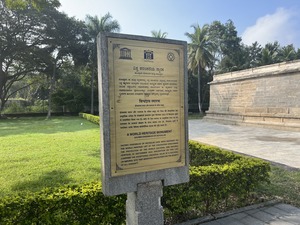Sacred Ensembles of the Hoysalas

The Sacred Ensembles of the Hoysalas represent a distinct style of Hindu temple architecture, with exuberantly decorated exterior and interior surfaces.
They comprise three groups of temples from the 11th – 14th centuries. The Hoysala Kingdom tried to distinguish itself from its neighbours, resulting in the patronage of architecture, art, and literature by the royal family and elites. The Chennakeshava temple in Belur remains an important pilgrimage center.
Community Perspective: Mihai visited Keshava Temple in 2012 and found it "different from everything we've seen so far". Shandos describes how to visit from Mysore and warns about only online tickets being available.
Map of Sacred Ensembles of the Hoysalas
Community Reviews
Shandos Cleaver

After booking cheap flights to the southern India city of Tiruchirappali (or Trichy for short), we were disappointed that we didn't have quite enough time to visit Kochi. However, I realised that with our spare day, we could visit one of the temples comprising the recently inscribed Sacred Ensembles of the Hoysala, just outside of Mysore.
Keshava Temple is located in the village of Somanathapura, a 45 minute drive outside of Mysore. It was quite easy to get there - we asked at the taxi stand opposite the main bus station and close to our hotel, and were immediately offered 1500 rupees for the afternoon trip (only slightly more than the 1200 rupees listed in the 2023 Lonely Planet). Lonely Planet also lists the option of taking a bus to Bannur and then a tuktuk to the temple.
Arriving at the temple, the hardest part of our visit was buying a ticket. Only online tickets are available, requiring a local SIM for the OTP (one-time pin). The security guards help out, but of course my credit card wanted to send me a security SMS, which was delayed by 5 minutes. Luckily an expat visitor helped us out and we gave him cash for our tickets, then entered the site through the well-maintained garden.
After having just visited the Chola Temple in Thanjavur and and the carvings at Mahabalipuram, we weren't expecting to be impressed by this small temple. But be prepared to be overwhelmed by the exquisite intricate carvings, both inside and outside of the temple. In particular, on the exterior are carved many scenes from Hindu texts - if you employ one of the guides at the entrance I'm sure you could spend hours finding out more about them. As it was, we spent an hour at the site, and I was happy to find one of the camels amongst the row of mounted horsemen.
We found Mysore a pleasant city, especially with its compact size in comparison to Chennai or even Coimbatore. Don't also miss visiting Mysore Palace in the centre of the city. Our Lonely Planet claimed it was World Heritage listed (!!), but I believe their claim that it's the 2nd most visited monument in India after the Taj Mahal - it's a shoeless shuffle amongst throngs of selfie-takers along the set route through a palace I dubbed the Versailles of India. Allow about 45 minutes. Unfortunately, after our 5:50am express train from Chennai, we skipped the light and sound show.
Mihai Dascalu

I visited Keshava Temple in January 2012, during a 15 months round the world trip with our 3 children. We spent 4 nights in Mysore and from there it was an easy trip to Keshava Temple. I got there because of a picture I have seen years ago on wikipedia. I thought it was amazing and I am very happy that it is now selected as a WHS. At the time I wrote in our blog:
"My temple! A picture seen somewhere on the internet a few years ago became a destination in itself.
Kesava temple was built in the 12th century and is a prime example of Hoysala architecture. What is that? Hoysala was another empire and civilization, between the 10th and 14th century, before all the other ones that we learned about. It had three main centers, and Somnathapur (or Somanathapura) was one of them. Just 45 minutes from Mysore, it was a quick, easy ride. A little temple, the one from my picture, is awaiting it's visitors on a laid back, quiet Sunday morning. We spent two entire hours going in and around it. It is different from everything we've seen so far. We had time to experiment with pictures, take turns with the camera, read in wikipedia about the specifics of this type of architecture. There are layers over layers of sculptures, starting with elephants at the bottom, then horses, then people. There are scenes from the famous Mahabharata, Ramayana and Bhagavat Gita, and the life and times of the Hoysala kings. Similarly, churches and temples all over the world have this educational side to them. Before the printed books, people could come to the temple and "read" the "scripture" in sculpture or painting.
I don't know how to interpret the children's reaction, "is this the only temple for today?" - they loved the easy schedule and being able to take their time."
Read more from Mihai Dascalu here.
Site Info
Site History
2023 Advisory Body overruled
ICOMOS had advised Referral
2023 Inscribed
2022 Postponed
Due to >1 nomination proposed by State Part in same year
Site Links
Unesco Website
Connections
The site has 10 connections
Constructions
History
Human Activity
Religion and Belief
Timeline
World Heritage Process
Visitors
24 Community Members have visited.
The Plaque
 (photo by Els)
(photo by Els)